Passport characteristics, scope of delivery and price
| Manufacturer | cooler master |
|---|---|
| Model name link | Hyper 212 Evo V2 |
| Model code | RR-2V2E-18PK-R1, EAN: 4719512101476 |
| Type of cooling system | for an air tower processor with active airflow from a heatsink located on heat pipes |
| Compatibility | mat. boards with processor sockets: Intel: LGA2066, LGA2011-v3, LGA2011, LGA1200, LGA1366, LGA1156, LGA1155, LGA1151, LGA1150, LGA775; AMD: AM4, AM3+, AM3, AM2+, AM2, FM2+, FM2, FM1 |
| Cooling capacity | there is no data |
| Fan type | axial (axial), 1 pc. |
| Fan model | Cooler Master SickleFlow 120 (DF1202512RFMN), our review |
| Fan power | 12 V, rated current 0.15 A |
| Fan dimensions | 120×120×25 mm |
| Fan speed | 650-1800 rpm |
| Fan performance | 105 m³/h (62 ft³/min) |
| Fan static pressure | 24.7 Pa (2.52 mm w.c.) |
| Fan noise level | 8-27 dBA |
| Fan bearing | slide with screw thread (Rifle Bearing) |
| Fan life | 160 000 h |
| Cooler Dimensions (H×W×D) | 155×120×80mm |
| Cooler weight | there is no data |
| Radiator material | aluminum plates (0.4 mm thick) and copper heat pipes (4 pcs. ∅6 mm, direct contact with the processor cover) |
| Heat sink thermal interface | thermal paste MasterGel Pro in a syringe |
| Connection | fan: 4-pin connector (power, rotation sensor, PWM control) to the CPU cooler header on the motherboard. board |
| Peculiarities |
|
| Scope of delivery (better to check before buying) |
|
| Retail offers |
Description
The CPU cooler Cooler Master Hyper 212 Evo V2 is delivered in a colorful box made of medium-thick corrugated cardboard.

On the outer planes of the box, not only the product itself is depicted, but also its description is given, technical characteristics are listed, there are drawings with the main dimensions. Some of the images are varnished. The inscriptions are predominantly in English, but the main features are listed in several languages, including Russian. The cooler assembly is placed in a protective plastic tray, and fasteners and accessories are packaged in plastic bags and placed in a separate cardboard box.

The kit comes with installation instructions in the form of an accordion book of good printing quality. The information is mainly presented in the form of pictures and does not need translation. On the company’s website, we found links to the description and instructions in the form of PDF files.
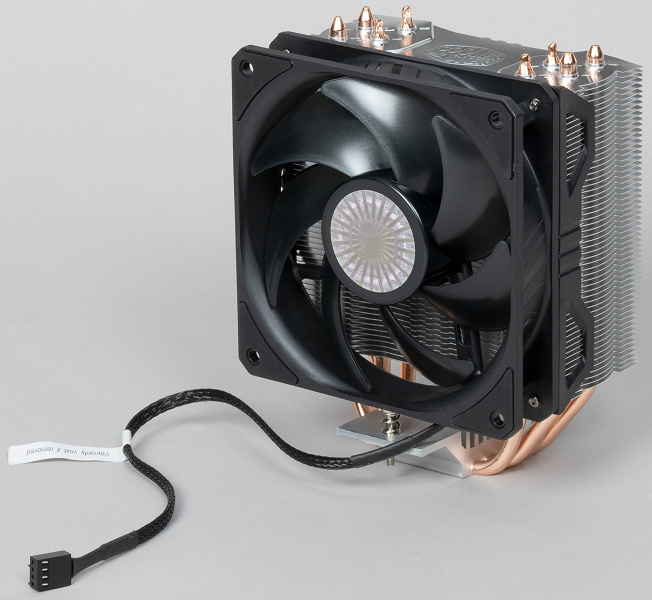
The cooler is equipped with a remote radiator, to which the heat from the processor is transferred through four heat pipes. The tubes are, of course, copper. At the base of the heat sink, the tubes are flattened and pressed into grooves. The heat sink is made of aluminium. The fins on top of the heat sink improve the performance of the cooler to some extent.
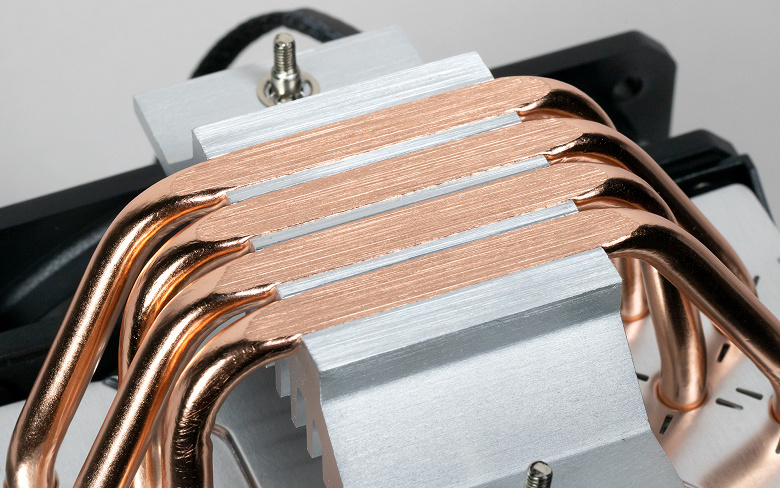
The tubes are ground flat together with the base of the heat sink. Before installation, the sole is protected by a plastic film.
There is no pre-applied thermal interface, but the manufacturer attached a small syringe with MasterGel Pro thermal paste to the cooler. A complete supply of thermal paste should be enough for two times in the case of processors with a small cover area and at economical consumption. The tests used no less high-quality thermal paste from another manufacturer. Looking ahead, we will demonstrate the distribution of thermal paste after all tests are completed. On an Intel Core i9-7980XE processor:
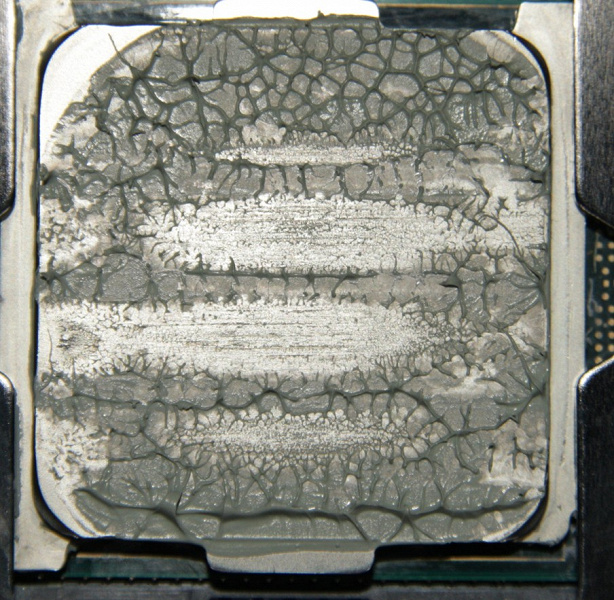
And on the sole of the heat sink:
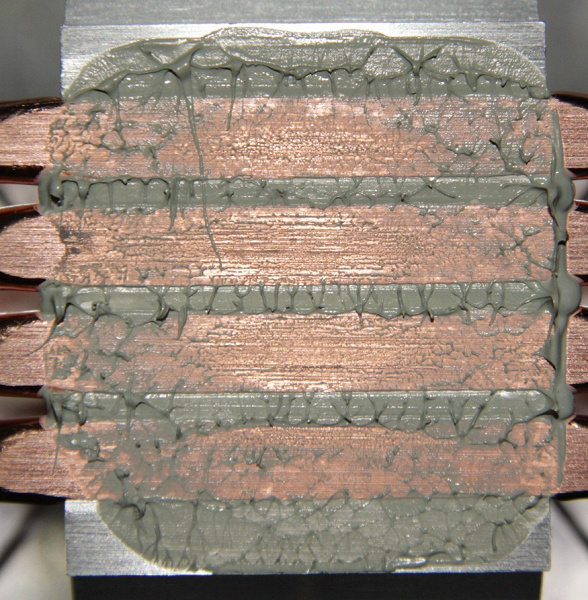
It can be seen that the thermal paste was thinly distributed over almost the entire plane of the processor cover, and its excess was squeezed out along the edges. In places where the tubes come into contact with the processor cover, there are areas of tight contact. Note that the cover of this processor is not perfectly flat, but slightly convex.
In case of AMD Ryzen 9 3950X processor. On processor:
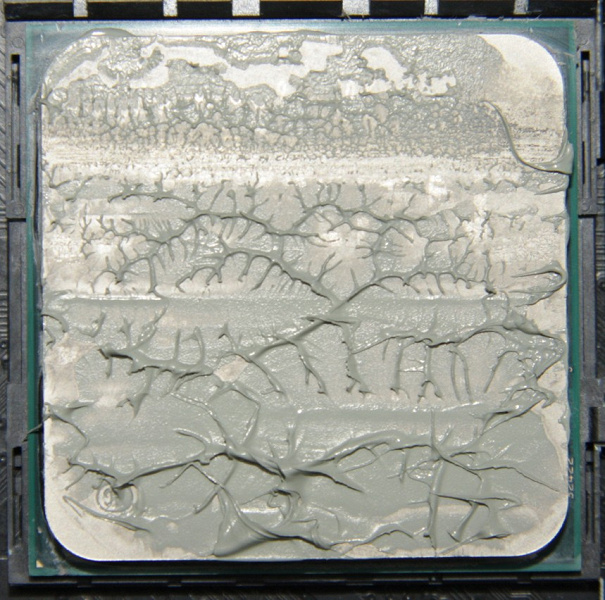
On the sole of the heat sink:

It can be seen that from one edge to the other, the thickness of the thermal paste layer increases slightly. We ran a second test, where we tried to eliminate skew by gently tightening the screws without much effort, but the result was exactly the same, both in terms of the type of thermal paste distribution and the data obtained.
The heatsink is a stack of aluminum fins tightly fitted onto the heatpipes.
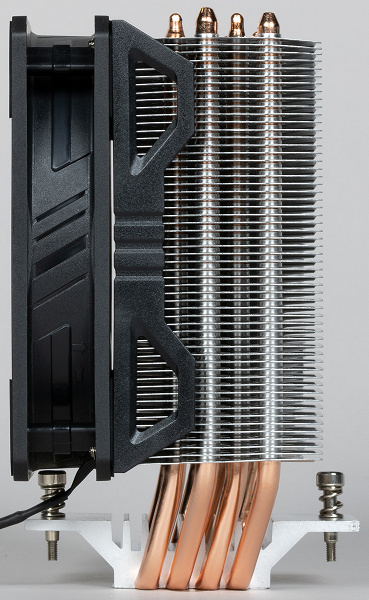
The heatsink is offset away from the fan, which ensures compatibility with high RAM modules. You can see it in the photo below:

There are four elongated holes in the radiator plates near the holes for the heat pipes, and in the center of the plates there are holes located in a triangle, all this, according to the manufacturer, improves heat transfer, including in the area where the pipes pass, by increasing turbulence.
The width of the fan dimensions is slightly larger than the working plane of the radiator, and the height of the radiator is quite a bit smaller than the inner diameter of the fan frame, so only a negligible part of the air flow passes by the plates.

Standard size of the complete fan is 120 mm. Frame height 25 mm. Two plastic brackets are screwed to the fan (two more are in reserve for installing the second fan), with which it is pressed against the radiator. Thanks to these brackets, the installation of the fan on the radiator is greatly facilitated. In places where the brackets are pressed to the radiator, small rubber pads are glued. Spare pads are included in the delivery. Rubber pads are also glued to the corners of the fan frame. In theory, these elastic elements should reduce vibration noise, but in practice this will not happen, since the mass of the fan and the rigidity of the vibration damping elements make it possible to reasonably assume that, due to the high resonant frequency, this system will in any case not have any significant anti-vibration properties. In addition, the self-tapping screws fixing the brackets are screwed into the fan frame itself, and the brackets hook directly onto the radiator plates, these rigid connections generally exclude any vibration isolation even in theory. But at least the option of a bounce due to a loose fit is excluded.
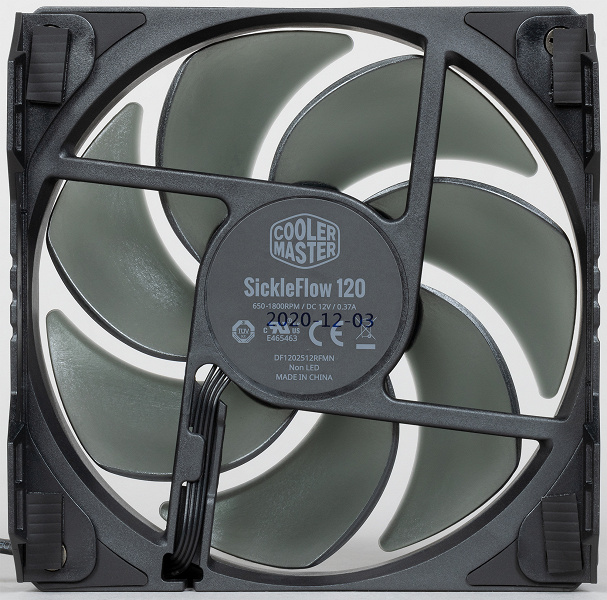
The cooler fan has a four-pin connector (common, power, rotation sensor and PWM control) at the end of the cable. The cable is encased in a slippery braided sheath. According to the legend, the sheath reduces aerodynamic drag, but taking into account the thickness of the flat four-wire cable inside this sheath and its outer diameter, we strongly doubt the veracity of this legend. However, the shell will allow you to maintain a single style of interior decoration of the case. To power a second fan, if the user decides to install one, there is a power splitter, the cable of which is also enclosed in a braided sheath.
The metal parts of the fasteners on the processor are made of hardened steel and have a durable galvanized coating. The bezel on the back of the motherboard is made of plastic and is not very rigid. Mounting on the processor is convenient.
The Cooler Master Hyper 212 Evo V2 comes with a 2-year warranty.
Testing
Below in the summary table we present the results of measurements of a number of parameters.
| Height, mm | 154 |
|---|---|
| Width, mm | 120 |
| Depth, mm | 92 |
| Heat sink surface, mm (along HP × across HP) | 37×42 |
| Cooler weight, g | 678 (with mounting kit for LGA 2011) |
| Radiator weight, g | 466 |
| Fin height, mm | 110 |
| Fan cable length, cm | thirty |
| Splitter length, cm | 23+23 |
A full description of the testing methodology is given in the corresponding article ” Testing methodology for processor coolers of the 2020 sample “. For the load test, the powerMax (AVX) program was used, all cores of the Intel Core i9-7980XE processor worked at a fixed frequency of 3.2 GHz (multiplier 32).
Determination of the dependence of the fan speed of the cooler on the PWM duty cycle and / or supply voltage

A good result is an almost linear increase in rotational speed with a change in the duty cycle (SC) from 20% to 95% and a fairly wide range of adjustment. Note that at a short circuit of 0%, the fan does not stop, so in a hybrid cooling system with a passive mode at minimum load, such fans will have to be stopped by reducing the supply voltage.

The range of adjustment using voltage in this case is about the same. The fan stops when the voltage drops to 3.0 V and starts from 3.2 V. It is quite acceptable to connect the fan to a source with a voltage of 5 V.
Determining the dependence of the temperature of the processor at its full load on the speed of rotation of the fan(s) of the cooler

At short circuit = 40% (approximately 960 rpm), the cooler can no longer cope with the cooling of the Intel Core i9-7980XE processor.
Determining the noise level depending on the rotational speed of the cooler fan(s)
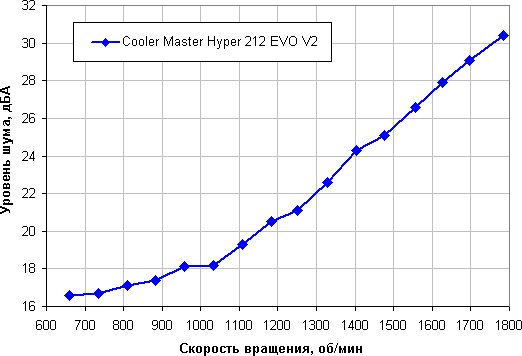
It depends, of course, on individual characteristics and other factors, but in the case of coolers somewhere from 40 dBA and above, the noise from our point of view is very high for a desktop system, from 35 to 40 dBA the noise level is tolerable, below 35 dBA noise from the cooling system will not stand out against the background of typical non-noisy PC components – case fans, on the power supply, on the video card, as well as hard drives, and somewhere below 25 dBA the cooler can be called conditionally silent. The background level was equal to 16.3 dBA (conditional value, which shows the sound level meter). Cooler Master Hyper 212 Evo V2 can be considered a relatively quiet device.
Plotting the dependence of the noise level on the temperature of the processor at full load

Plotting the dependence of the real maximum power on the noise level
Let’s try to get away from the conditions of the test bench to more realistic scenarios. Let’s say that the temperature of the air taken in by the cooling fan can rise to 44 ° C, but the temperature of the processor under maximum load does not want to be raised above 80 ° C. Restricting ourselves to these conditions, let’s plot the dependence of the real maximum power (denoted as P max (previously we used the designation Max. TDP )), consumed by the processor, on the noise level ( details are described in the methodology ):

Taking 25 dBA as a conditional noiselessness criterion, we get the approximate maximum power of processors corresponding to this level. This is about 185 W for an Intel Core i9-7980XE processor. If you do not pay attention to the noise level, then the power limits can be increased somewhere up to 200 watts. Let us clarify once again that in harsh conditions of blowing the radiator with air heated to 44 degrees, when the air temperature drops, the indicated power limits for silent operation and maximum power increase.
Comparison with other coolers when cooling the Intel Core i9-7980XE processor
Using this link , you can calculate the power limits for other boundary conditions (air temperature and maximum processor temperature) and compare this cooler with several other coolers tested using the same method (the list is being updated, and therefore placed on a separate page).
Testing on an AMD Ryzen 9 3950X processor
As an additional test, we decided to see how the cooler handles the cooling of the AMD Ryzen 9 3950X . The processors of the Ryzen 9 family are assemblies of three crystals under one cover. On the one hand, increasing the area from which heat is removed can improve the cooling capacity of the cooler, but on the other hand, the design of most coolers is optimized for better cooling of the central area of the processor. Apparently, because of these features, there is an opinion that it is not very easy to choose an air cooler for top-end Ryzen processors of the new generation.
The dependence of the temperature of the processor at its full load on the speed of rotation of the fans:
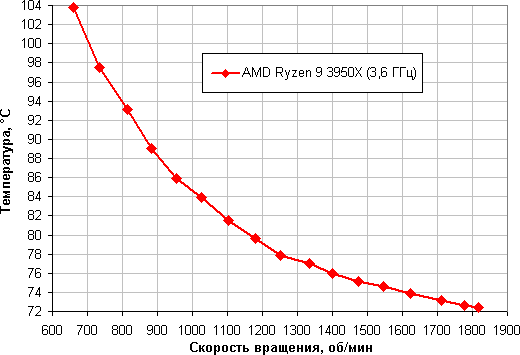
In fact, under test conditions, this processor already overheats at 24 degrees of ambient air (for this CPU, heating up to 95 degrees is acceptable) at a short circuit of 25% (which is about 730 rpm of fans).
The dependence of the noise level on the temperature of the processor at full load:
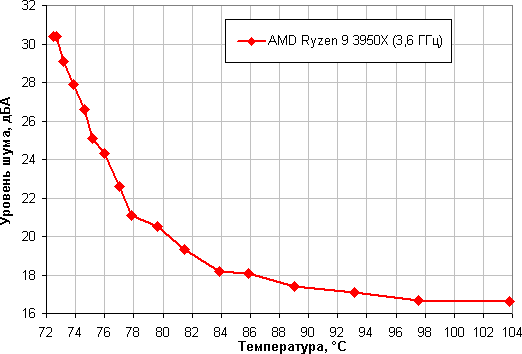
Restricting ourselves to the above conditions, we plot the dependence of the real maximum power (denoted as P max ) consumed by the processor on the noise level:

Taking 25 dBA as a conditional noiselessness criterion, we get that the maximum processor power corresponding to this level is about 104 W. If you do not pay attention to the noise level, then the power limit can be increased to somewhere up to 109 watts. Once again, we will clarify: this is in harsh conditions of blowing the radiator with air heated to 44 degrees. As the air temperature drops, the specified power limits for quiet operation and maximum power increase. Therefore, provided there is enough good ventilation in the case, this cooler will somehow cope with the cooling of the AMD Ryzen 9 3950X processor, but you should not count on the possibility of significant overclocking.
Comparison with other coolers when cooling AMD Ryzen 9 3950X CPU
Using this link , you can calculate the power limits for other boundary conditions (air temperature and maximum processor temperature) and compare this cooler with several other coolers tested using the same method (the list is being updated, and therefore placed on a separate page).
findings
Based on the Cooler Master Hyper 212 Evo V2 cooler, you can create a conditionally silent computer (noise level 25 dBA or less), equipped with an Intel Core i9-7980XE (Intel LGA2066, Skylake-X (HCC)) processor, if the processor consumption under maximum load is not will exceed 185W and the temperature inside the case will not rise above 44°C. In the case of the AMD Ryzen 9 3950X chiplet processor, the cooler efficiency is noticeably lower, and in order to comply with the above conditions, the maximum power consumed by the processor must not exceed 104 watts. With lower cooling air temperatures and/or less stringent noise requirements, the power limits can in all cases be increased. The advantages of the cooler include a neat design, easy installation of the cooler on the processor and the fan on the heatsink, the fact that it does not block the slots for memory modules, and the readiness to install a second fan.




